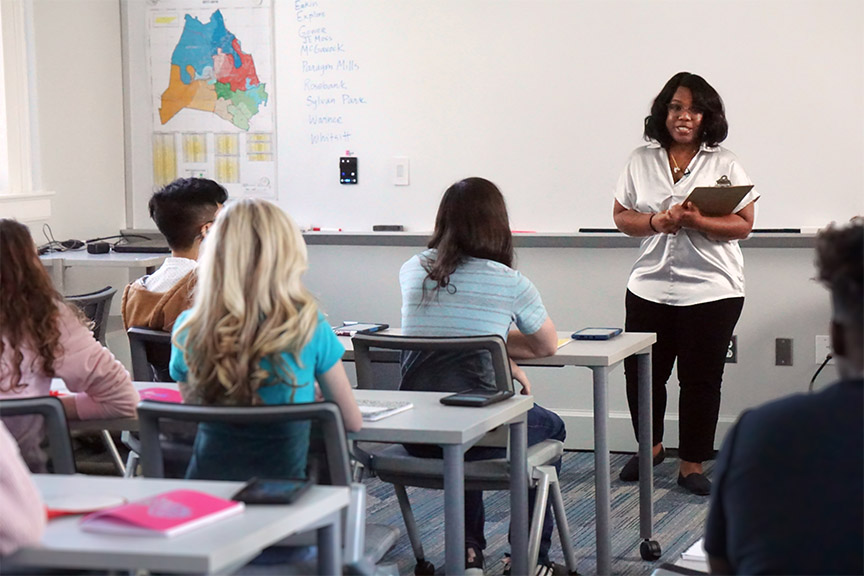What strategies can educators implement to prevent or address challenging behaviors?
Page 3: Precorrection
 Precorrection is a strategy that involves determining when challenging behaviors tend to occur and then making changes to the classroom environment or providing proactive supports for students during those times. By doing so, educators can prevent those challenging behaviors from happening and facilitate appropriate behavior. For example, transitions are often a time teachers encounter challenging behavior. Even simple changes to the environment (e.g., instructions, reminders, a visual timer) can help prevent challenging behavior and facilitate a smooth transition.
Precorrection is a strategy that involves determining when challenging behaviors tend to occur and then making changes to the classroom environment or providing proactive supports for students during those times. By doing so, educators can prevent those challenging behaviors from happening and facilitate appropriate behavior. For example, transitions are often a time teachers encounter challenging behavior. Even simple changes to the environment (e.g., instructions, reminders, a visual timer) can help prevent challenging behavior and facilitate a smooth transition.
Research Shows
Precorrection has been proven effective to increase positive behavior and prevent common challenging behaviors:
- Across age groups (i.e., preschool to high school)
- In classroom and non-classroom settings
- When implemented by a variety of educators (e.g., teachers, school staff)
(Evanoich & Kern, 2018; Ennis, Royer, Lane, & Griffith, 2017; Ennis, Schwab, & Jolivette, 2012; Haydon, DeGreg, Maheady, & Hunter, 2012; Haydon & Scott, 2008)
Using the Strategy
To help educators prevent or address challenging behavior, the table below describes the steps to implement precorrection and provides an example.
| Steps | Description | Example |
|
To prevent a challenging behavior, you must first anticipate the nature of that behavior and identify the context in which it is likely to occur (e.g., activity, setting, time). |
The teacher identifies the context in which challenging behavior occurs. Context: Coming late to class. Challenging Behavior: After lunch, Jordyn consistently comes late to English class. When this happens, he typically interrupts instruction as he enters the classroom. |
|
As part of creating a safe and respectful classroom environment, establish and explicitly teach behavioral expectations—that is, the behaviors you want your students to display. |
Classroom: Be in your seat when the bell rings. Because Jordyn often comes late to class, the teacher establishes the following expectation with Jordyn. Student: Jordyn will be in his seat when the bell rings. |
|
To facilitate student success, make changes to the context that support appropriate behavior, based on your students’ needs. |
Because students have seven minutes to transition from lunch to their next class, the teacher decides to project a seven-minute countdown timer that students can view as they walk by the classroom, talk with friends, and gather materials at their lockers. |
|
Practice makes perfect—maybe not immediately, but it’s a step in the right direction. To set students up for success, review and practice the expected behaviors. This can include options such as discussion, question and answer, or role play. |
During class, the teacher goes over the behavioral expectation. She shows students the seven-minute countdown timer and reminds them that they should be in their seat and ready to go when the bell rings (i.e., before the countdown timer hits zero). In addition to this, she meets with Jordyn privately to discuss the importance of coming to class on time. They discuss how he can refer to the countdown timer to know how much transition time is left before he needs to be in his seat. |
|
When students engage in an expected behavior, provide positive reinforcement to increase the likelihood that they will continue to do so. |
When Jordyn references the countdown timer and is in his seat before the bell rings, the teacher immediately delivers behavior-specific praise. |
In addition to the five steps listed above, the three actions below can be helpful when implementing this practice.
Beyond teaching, practicing, and reinforcing appropriate behaviors, you will need to regularly prompt or remind some students of the expected behavior. As part of your plan, anticipate situations in which the student will need support and be prepared to:
- Offer immediate and specific reinforcement when a student engages in the desired behavior (i.e., Step 5).
- Build in prompts and reminders in daily classroom activities.
- Brainstorm how to deliver reminders. These can be in the form of gestures (e.g., finger on ear to signal a group needs to quiet down), verbal prompts, or environmental prompts (e.g., expectations poster).
Although precorrection has been shown to be effective, you need to determine whether your specific precorrection procedures are effective in preventing or decreasing challenging behaviors and increasing expected behaviors. This can be accomplished by collecting data on the occurrence of inappropriate behavior before and after implementing precorrection. This can be as simple as keeping a record of how often the inappropriate behavior occurs, or it may require different types of data collection (e.g., duration, latency).
duration
The amount of time a student engages in a specific behavior (e.g., time on-task during independent classwork).
latency
The time between when a direction is given and when the student complies (e.g., how much time passes between when a direction is provided and the behavior begins).
Students can be valuable sources of information. Consider asking them whether they find the teacher prompts and reminders helpful and what types of supports they need to be successful.
In this interview, Johanna Staubitz offers more information about how to implement precorrection (3:20).

Johanna Staubitz, PhD, BCBA-D
Associate Professor
Department of Special Education
Vanderbilt University
Transcript: Johanna Staubitz, PhD, BCBA-D
Precorrection is a relatively simple strategy to prevent common, widespread, or otherwise impactful behavior issues in the classroom. For example, let’s say that from time to time you have to transition your class to an assembly from an instructional activity. This is often very, [laughs] very difficult, but you might precorrect that by just saying something along the lines of, “Do not move yet. Remember the routine for lining up that we practiced. When I release you, walk calmly and quietly to the door.” That’s a precorrection. So to use precorrection, you start with a behavior that you’d like to change. Just ask yourself [laughs] what’s annoying you the most right now and you’ve identified one of those behaviors. And then ask yourself, is that behavior correlated with certain contexts, or what antecedent variables might be influencing that behavior? Then you want to clearly identify something that you want students to do instead of that behavior that’s at issue. This replacement behavior has to be within the students’ repertoires—something they’re capable of doing—and if not, explicitly teach it. And in fact, to precorrect, you should explicitly reteach that expectation, even if you believe the students already can do it. After you identify those things, you make some changes to the situation in ways that support the expected behavior. Address antecedent factors that contribute to the problem. You can do this by adding visual supports or verbal reminders. And you also want to follow up. When students engage in the expected behavior, reinforce it. Make sure there are natural consequences that support that behavior. Use praise. You can even apply more tangible reinforcers if you need to.
Some things to know is that precorrection could apply class-wide, individually, or somewhere in between, just depending on for whom this behavior is a struggle. So, for example, to apply precorrection class-wide, think of that transition example from earlier, but let’s also say most students leave their materials out instead of putting them away after an activity. Reteach the routine for putting things away, give opportunities to practice, and give them feedback. Then simplify the environment. Maybe you set bins aside for those items and remove other items from that area. Use visual cues, post a reminder, and then give a verbal reminder at the end of the activity. Finally, you want to reinforce it. Maybe use a group contingency. “If everybody puts all their materials away, everybody gets a couple of minutes of free time at the end of class.” When precorrection is applied individually, this could look like a student who has trouble with a certain type of assignment. Maybe they walk out of class when they get really frustrated or fatigued with it, and this is something that happens over and over, so we need to make some kind of change. Talk with the student about what they need to do and can do instead to identify that replacement behavior, maybe asking for a water break. Then remind them, provide that verbal cue, change the antecedent by doing that at the start of an activity that’s typically frustrating. Maybe use a post-it note to give that reminder if the student cares about the attention drawn to them. Most important, reinforce the expected behavior by allowing that break that they’re asking for. Maybe a handful of students tend to shout out versus waiting to be called on. In those cases, you want to just apply the reminder to that group of students or maybe the whole class, even if it’s only a few who need the reminder. So precorrection is a relatively simple and easy tool to apply when you have a good understanding of the conditions for a given behavior issue and what you’d like to see students doing instead.
Tier 2 Support
Although precorrection can be used as a Tier 1 strategy, it can also be used as a Tier 2 support for students with moderate levels of externalizing or internalizing behaviors. The steps are the same as when used as a Tier 1 support, but for Tier 2 the educator delivers precorrection with greater intensity (e.g., provides more practice opportunities, reminders). To determine if the strategy is effective, the educator collects and analyzes the data using the following steps:
- Identify the student behavior to be addressed (e.g., student makes off-topic comments during class discussions) during an instructional period in which the behavior typically occurs (e.g., science, math).
- Collect baseline data on the student behavior for a designated timeframe (e.g., first 20 minutes of class) during the identified instructional period. Collect this data across several days (e.g., 3 to 5 days) to see how often this behavior occurs or how long each episode lasts.
- Implement or intensify precorrection and continue to collect data (e.g., same instructional period, same length of time) for 3 to 5 days to determine whether the student’s behavior changes.
- Evaluate the effect of precorrection. Compare the implementation data to the baseline data to evaluate whether the strategy has had the desired effect on the student’s behavior.

To make sure you are using this strategy with fidelity, download this precorrection implementation checklist. To view our IRIS Fundamental Skill Sheet on precorrection, click the title below. |